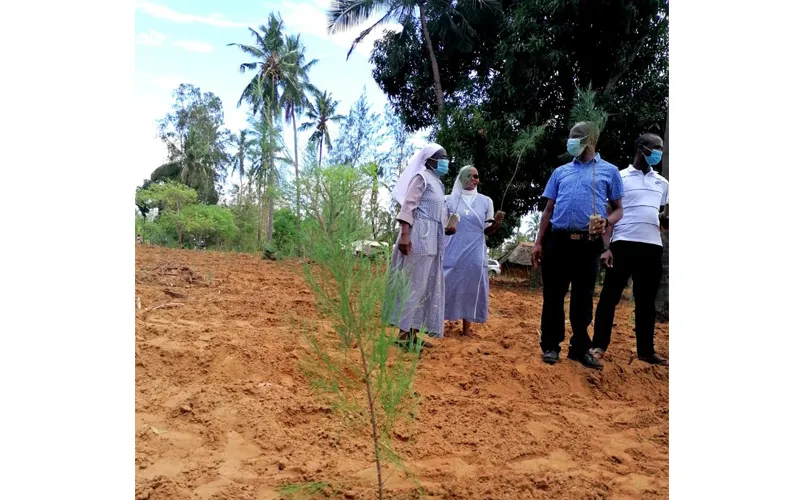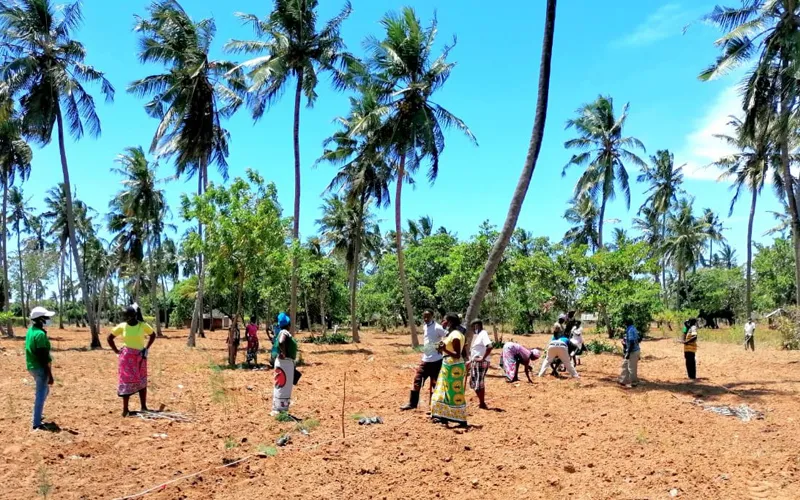“I applaud the Church and especially Pope Francis for his commitment towards environmental conservation and how the practice trickles down to our Dioceses and Parishes,” said Bishop Lagho.
He added, “Christians err when they get more concerned about heaven and the hereafter instead of worrying about the here now. We need to start taking care of the earth as our common home especially for the coming generations.”

The “Church Forest” model is what Moses Mpuria, the Executive Secretary of the Catholic Justice and Peace Commission of Kenya’s Malindi Diocese refers to as “a late response to the call by Catholic Bishops in Kenya to all Dioceses to plant trees.”
In 2018, the Kenya Conference of Catholic Bishops (KCCB), through Caritas Kenya, launched an environmental campaign to raise awareness on the steps that Kenyans should take to conserve the environment and address pollution. This initiative was marked by the planting of over 2,500 trees at the Shanzu teachers training college in the Archdiocese of Mombasa.
(Story continues below)
“We didn’t know how to go about the project. We didn’t have the resources and the technical knowhow. That’s why it took us long to implement the call by the Kenyan Bishops” Mr. Mpuria told ACI Africa on April 13.
He added, “What we did was a little beautification in our parishes by planting grass and a few trees here and there. But all the time, we wanted to have something as big as what has just happened in Mida.”
Some two and a half acres of land were set aside some 500 metres from the Mission in Mida for the Church forest.

It is the same section of land that Fr. Martin Karigu, the Priest in charge of the Catholic mission, used to grow cassavas, green grams and maize for consumption at the mission.
Fr. Karigu was glad to give the chunk of land away “for an even greater purpose.”
“I realized that I don’t need the cassavas, the maize and the food I grew on the piece of land anymore. If I need food, my parishioners will be willing to share. It is better that this land becomes a forest for all to learn the importance of growing trees,” Fr. Karigu told ACI Africa April 13.
The Kenyan Cleric who was previously at the helm of Caritas Malindi said that Kilifi is one of the regions in Kenya where locals need most awareness on environmental conservation.
“People are crying everywhere because of the lack of rains. Today, our Bishop told us that forests and people are related and that when we cut down trees, we destroy the very core of our existence,” said Fr. Karigu.

Kilifi is especially notorious in charcoal burning, an activity that Fr. Karigu blames on the high poverty levels in the region.
“Residents of Kilifi are among Kenya’s poorest people and they rely solely on fishing and farming. But what they harvest is barely enough to last them long and so many resort to charcoal business. This has resulted in high levels of deforestation,” he says.
With the “Church Forest” model tree plantation, Caritas Malindi aims to plant over a million trees in various parishes of the Kenyan Diocese, the Cleric divulged.
About 100 parishioners participated in the planting of the 1,750 Arborea and Casuarina trees that were donated by the Kenya Forestry Research Institute (KEFRI) in Kilifi.
The partnership with the research institution was aimed at capacity building and to bring on board as many people as possible.
“We want to get the best seedlings, those with high survival rates and which have been expertly propagated,” Mr. Mpuria told ACI Africa.
KEFRI Kilifi Assistant Research Scientist, Gladys Ruto, on her part, said that the Church for its advocacy role in society would be instrumental in bringing many locals on board in the institute’s quest to improve forest cover in the coastal town.
The research institution, she said, had embarked on equipping locals with best technological practices in tree planting.
“We have done a lot of research on the tree species that can survive in this region and some technologies such as tree spacing to employ to ensure that the trees thrive. We’ll be happy to pass on this knowledge to the locals,” Ms. Ruto said, and added that the institution had produced the Soil Capability Map, a guide on planting commercial trees.
The choice of commercial trees is aimed at providing locals with alternative sources of livelihoods, Bishop Lagho said.

“When we tell the people to stop cutting down trees to burn charcoal, we have to give them something in exchange,” he said, and added, “What we are growing are commercial trees including fruit trees for locals to benefit from.”
In his tenure, the Bishop who has served Malindi Diocese for about 25 days (as of 13 April 2021) says that he aims to encourage the use of green energy to prevent charcoal burning in the region.
“We want to give people alternatives such as the use of solar and so, I am looking for partners who will help locals use the freely available sunshine to cook in their homes rather than rely on charcoal and firewood,” the Kenyan Bishop said, adding that the culture will also reduce the oppression of school going girls who, he said, waste a lot of time looking for firewood after school.
Meanwhile, Bishop Lagho said that his 25-day experience as the Local Ordinary of Malindi Diocese had been quite enriching.
“The highlight of my appointment has been the Holy Week and Easter celebrations with the St. Antony Cathedral, a very lively community,” Bishop Lagho told ACI Africa April 13.
He added, “I have also visited various groups of men, women and children in the Dioceses and I intend to visit all the parishes including the various outstations in our Diocese in the coming four months through the grace of God.”
“I will set aside days that I will celebrate Holy Masses in three different outstations on each day. I believe that it is only by understanding the terrain of our Parishes and outstations where our Priests work that we as Bishops are able to understand the Priests’ challenges when they come to us,” the Prelate who was ordained Bishop on the Solemnity of St. Joseph, March 19, told ACI Africa.
Agnes Aineah is a Kenyan journalist with a background in digital and newspaper reporting. She holds a Master of Arts in Digital Journalism from the Aga Khan University, Graduate School of Media and Communications and a Bachelor's Degree in Linguistics, Media and Communications from Kenya's Moi University. Agnes currently serves as a journalist for ACI Africa.















